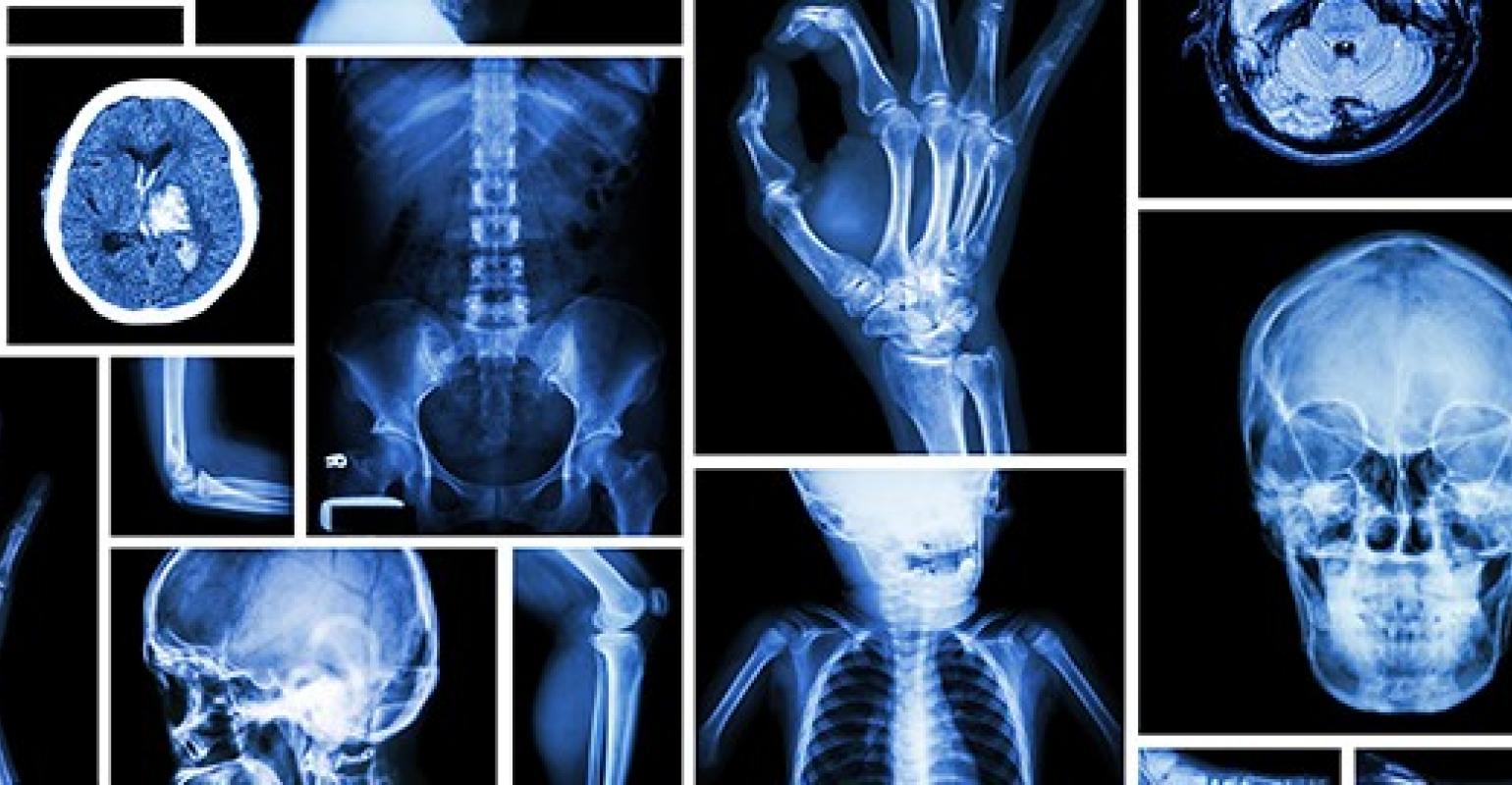

General x-ray
Radiography is the imaging of body structures using x-rays, which are a form of radiation similar to visible light, radiowaves and microwaves.
General x-ray
Radiography is the imaging of body structures using x-rays, which are a form of radiation similar to visible light, radiowaves and microwaves.

What is a general or plain x-ray?
Radiography is the imaging of body structures using x-rays, which are a form of radiation similar to visible light, radiowaves and microwaves. X-radiation is special because it has a very high energy level that allows the x-ray beam to penetrate through the body and create an image or picture.
The image is created due to the x-ray beam being absorbed differently by different structures or parts in the body. A dense structure like bone absorbs a high percentage of the x-ray beam (which appears light grey on the image), while low density structures like soft tissues absorb a small percentage (which appears dark grey on the image). The body has many different structures of varying densities and this difference creates a picture or image.
How much will my procedure cost?
Fees for radiology procedures vary and depend on a number of factors, including the type of procedure, what has been requested on your referral and the Medicare rebates available. We will advise you of any fees associated with your examination at the time of making your appointment or when you arrive at the clinic. Alternatively you can contact us and one of our team will be happy to answer any queries regarding fees. For more information about fees and rebates please visit our account FAQs.
What happens during a plain x-ray? keyboard_arrow_down
The radiographer (a trained x-ray technologist) will call your name and escort you through to an examination room. They will explain the procedure and prepare you accordingly.
Depending on the part of your body being examined you may be asked to stand, sit or lie down while the x-ray is taken. The number of x-rays taken and the speed of the test will also depend on this. It is important that you stay completely still when the radiographer instructs you to, as any movement may create a blurred image.
After the x-rays have been performed, the radiographer has to process each x-ray and check the results for quality. This can sometimes take several minutes. Sometimes there will be a need for additional images to be taken to obtain more information to help the radiologist (a specialist doctor) make a diagnosis. There is no need for concern if this happens as it is quite common.
The radiographer will instruct you when the procedure is finished. The radiologist then carefully assesses the images, makes a diagnosis and produces a written report on the findings, which is sent to your referring doctor.
The entire process is straightforward and you will not feel anything strange or feel any different during the examination. You are welcome to ask questions at any stage.
How do I prepare for a plain x-ray? keyboard_arrow_down
For a plain x-ray there are no specific preparation instructions. You must however bring the x-ray request form or referral letter from your doctor, as no x-ray examination can be performed without it.
- Please inform the radiographer who is performing the x-ray if there is any chance you may be pregnant. Safety of the patient and unborn child is the number one priority so a different approach or test may be needed. As some clothing can make it difficult to see the images clearly, be prepared to wear a gown.
- Be prepared to remove certain items like watches, necklaces and certain types of clothing that contain metal objects such as zips, as these items may interfere with the quality of the image.
Who does plain x-rays? keyboard_arrow_down
A radiographer or medical imaging technologist is a health professional who performs diagnostic radiography. A radiologist is a specialist medical doctor who reviews and interprets the images and provides a written report of the test to your referring doctor.
How long do plain x-rays take? keyboard_arrow_down
The radiographer (a trained x-ray technologist) will call your name and escort you through to an examination room. They will explain the procedure and prepare you accordingly.
Depending on the part of your body being examined you may be asked to stand, sit or lie down while the x-ray is taken. The number of x-rays taken and the speed of the test will also depend on this. It is important that you stay completely still when the radiographer instructs you to, as any movement may create a blurred image.
After the x-rays have been performed, the radiographer has to process each x-ray and check the results for quality. This can sometimes take several minutes. Sometimes there will be a need for additional images to be taken to obtain more information to help the radiologist (a specialist doctor) make a diagnosis. There is no need for concern if this happens as it is quite common.
The radiographer will instruct you when the procedure is finished. The radiologist then carefully assesses the images, makes a diagnosis and produces a written report on the findings, which is sent to your referring doctor.
The entire process is straightforward and you will not feel anything strange or feel any different during the examination. You are welcome to ask questions at any stage.
What are the risks of plain x-rays? keyboard_arrow_down
Generally, the benefit of the x-ray procedure is far more important than the small estimated risk. At the radiation dose levels that are used in diagnostic radiography there is little or no evidence of health effects.
The two major risks to health that occur as a result of exposure to medical ionizing radiation (which is the kind of radiation in x-rays) are:
- Cancer occurring many years after the radiation exposure
- Health problems in the children born to people exposed to radiation because of damage to the reproductive cells in the body.
To put this into perspective, a patient would need to have approximately 38 chest x-rays to receive an amount of radiation similar to that of normal background radiation that everyone receives for one year from the environment.
Do I need a referral, and do you accept all referrals? keyboard_arrow_down
You will need a referral to access x-ray services at I-MED Radiology. Your healthcare provider (general practitioner, specialist, allied health practitioner etc.,) needs to issue a referral based on your clinical needs. I-MED Radiology accepts all referrals, but it's essential to check with the specific I-MED clinic you plan to visit to ensure they perform the particular service your practitioner has referred you for.
Will my x-ray be bulk billed or not? keyboard_arrow_down
Many x-rays are partially covered by a Medicare rebate, meaning the rebate from Medicare is often less than the actual cost of providing the service. For this reason, there is usually a 'gap' payment charged to the patient. The gap payment is the difference between the fee for our services and the Medicare rebate. The size of the gap payment varies depending on the type and number of tests, and the complexity. Additionally, for some tests, there may not be a Medicare rebate at all. Pensioners and healthcare card holders are bulk billed for most Medicare rebateable imaging procedures.
To discuss the cost of your x-ray, contact I-MED Radiology by calling your local clinic and select the 'Booking' option in our phone system. Find your local clinic details here.
How do I get my results? keyboard_arrow_down
Your doctor will receive a written report on your test as soon as is practicable.
It is very important that you discuss the results with the doctor whom referred you so that they can explain what the results mean for you.
Related procedures
Related articles

Related procedures
How much will my procedure cost?
Fees for radiology procedures vary and depend on a number of factors, including the type of procedure, what has been requested on your referral and the Medicare rebates available. We will advise you of any fees associated with your examination at the time of making your appointment or when you arrive at the clinic. Alternatively you can contact us and one of our team will be happy to answer any queries regarding fees. For more information about fees and rebates please visit our account FAQs.
Related articles

